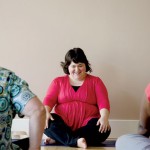
by Kara-Leah Grant,
Do enough research, and it seems we can find evidence that regular practice of yoga can positively impact everything from anxiety, depression, and panic attacks to thyroid conditions, sciatica and asthma.
In fact, it could be said that yoga can positively impact anything that has to do with the functioning of our physical bodies, minds or emotions.
How can this be possible? Surely yoga’s not a silver bullet?
Well no, it’s not.
However, yoga works to harmonise the body, mind and emotions by removing blockages on all levels of our system. The removal of these blockages allows our bodies, minds and emotions to function at their optimum level.
Remember, yoga is often referred to as the Science of Life – and with good reason.
Over the centuries, yogis have used practice of yoga (in its broadest dimensions) to experientially collect information about the way they function.
This information has been codified for easy explanation, and now the work of Western scientists is corroborating more and more of what the yogis learned experientially.
The yogis define our body as having five layers, or sheaths, each one contained within the other, like Russian Dolls.
Called Koshas, these sheaths cover every aspect of our being, from the most gross to the most subtle.
When we practice yoga – whether it’s asana, pranayama, meditation, mantra, or even karma yoga – we are having an impact on one or more of these layers of the body.
For example, asana will primarily affect the grossest layer of Kosha, Annamaya. Of course, anything that affects one kosha will also affect the other koshas because there is no real separation between the layers. They are a conceptual method of understanding that allows us to make sense of our experience.
When you understand that the practice of yoga works to release blockages in the many layers of the body it helps you understand why sometimes we resist – strongly resist – our practice.
Those blockages in our body often hide fears and unexpressed emotions. Sure, yoga will make you feel great, but it will also make you FEEL.
Sometimes what we feel during or after yoga isn’t wonderful, and it helps to have a conceptual model to understand why this can be.
Back to the Koshas. And I’ll keep it short.
Kosha #1 is Annamaya kosha – the outside layer of the body, and roughly translates at the food body.
This is our physical body – our muscles and our bones, our ligaments and our tendons. This is the kosha most people are concerned about when they begin a yoga practice. They want increased flexibility, they want to tone up their muscles, they want to learn to relax their bodies, they’re looking to gain strength, improve their balance and find stress relief.
The primary way to impact this kosha is through asana.
The practice of asana will also impact Kosha #2, Pranamaya kosha – the energy body.
Like the Chinese have chi, the yogis have Prana – or life force. Prana moves around the body via channels, or nadis. Some 72,000 apparently, although who counted them, nobody knows. When we practice asana and pranayama, we are impacting Pranamaya kosha.
Any blockages in those nadis (and believe me, you’ll have blockages) are worked through, bit by bit. And your improved flow of energy in the body can then affect the Annamaya kosha and also impact any health issues you may be having.
Prana comes into the body via food and water, but it also comes into the body via breath. One of the major benefits of yoga is that we become conscious of our breathing, and – sometimes for the first time as adults – we learn to take proper deep breaths.
This increase of prana into our system literally makes us feel more alive and it invigorates and powers Pranamaya kosha.
#3 on our tour of the Koshas is Manomaya kosha, the mental body.
People usually come to yoga for the physical benefits and stay because of how yoga impacts Manomaya kosha. Put bluntly, you feel bloody great after class – mentally clear and emotionally up-beat. That’s what keeps you coming back, time after time.
Manomaya kosha is that aspect of Self which takes care of our instinctual needs, plus it also helps us obtain our individual desires. On a practical level that means it’s about safety, security, obtaining love and taking care of loved ones.
If you’re experienced underlying anxiety because you’ve lost your job and you don’t know how you’re going to pay rent, you’re experiencing that in Manomaya kosha. A calming yoga practice like Alternate Nostril Breathing can alleviate those feelings and thoughts.
Most of us have a tendency to ‘live’ in one kosha more than the others. Some people are body-orientated, Westerners tend to be mind-orientated. However, the practice of yoga helps us to balance out our awareness of all the layers of Self and shift us out of being primarily just in Manomayakosha.
This can mean that our anxiety fades somewhat. It will still be there, but we may be more grounded in Annamayakosha or kosha #4 – Vijnanamaya kosha, the wisdom body.
That grounding in the Wisdom body gives us a broader perspective on our life experience, and we’re able to see that we’ll get another job, or that we have plenty of resources to call on. The anxiety fades.
Cultivating Kosha # 4 – Vijnanamaya kosha is an unexpected benefit of yoga for most people.
You turn up expecting an exercise class and wanting to touch your toes. But you find yourself connecting to a deeper level of intuition, greater internal wisdom and a sense of higher knowledge.
Granted, deepening into an awareness of Vijnanamaya kosha may take more a class once a week, but if you continue to practice, it will come.
It’s at this more subtle level of our Self that we begin to shift from a primary I-ness orientation – I am a separate being – to a primary One-ness orientation. We feel, and understand, on a deep level that there is no real difference or separation between Me and You.
We move beyond feelings and concern based on survival and security, and into feelings that encompass and include all – like compassion, love, and joy. Our relationships change, and become more fulfilling, and more joyous. Life simply becomes good. We’re well along the path of yoga and that journey from ego/mind or small self to Atman or Big Self.
Shifting into Vijnanamaya kosha is mostly about doing the work that removes the blockages in the three lower koshas. We find comfort and harmony in our physical body, we release blockages in our energy body, and we heal and release fears from our mental body.
Shifting more and more into Vijnanamaya kosha is like watching life upon up before you, into an expansive landscape where you love everyone. Truly love everyone.
Now that’s a pretty cool benefit of doing a few sun salutations every day huh?
Finally, there’s Kosha #5. Anandamaya kosha, or the Bliss Body.
Exactly as it sounds, it’s all about the Bliss Baby. No longer separate, you’re bathing in One-ness with All that Is. You and God, you’re One and the Same. And that’s about all I’m going to say about kosha #5, because if you’re getting there, you don’t need me to tell you about it. And if you’re not there, I can’t tell you about it, because I’m not there either.
Yet.
As you practice, no matter what style or kind of yoga you’re practicing, you’re releasing blockages in one or more of these layers of the body.
That can mean old memories – both good and bad – floating to the surface of your consciousness. It can mean the spontaneous release of emotion like tears or laughter. It can mean jerking of the body as energy releases in strange ways.
All of this is normal.
All of this can be part of your yoga experience.
So bear this in mind next time you practice – sense your way into your physical body, your energetic body, your mental body, your intuitive body… and maybe even your bliss body.


Brilliant! Keep them coming★ have a great 1st of spring day xx
Hey Margo,
What’s brilliant exactly – and keep what coing? Happy to oblige but good to confirm what you mean – articles like this on yoga philosophy?
Your are brilliant to put so much of your energy into The yoga lunch box articles. I particularly liked the one on yoga philosophy. Namaste
Ah… thank you Margo. I love it.
Well done, Kara-Leah. This is a great explanation of something that is easy to over complicate.
Posting to Best of Yoga Philosophy.
Bob W.
Yoga Demystified
Thank you Kara-Leah, I really enjoyed this article. It’s so lovely to read and draw inwards on a greater spiritual understanding. Thank you for sharing, much love.
Hey Sky,
My pleasure. 🙂
Hi kara-Leah,
I enjoyed the well written article, thank you for posting.
I have shared it with our Facebook Yoga followers with a link back to your blog.
https://www.facebook.com/DownDogBoutique
Regards
Terri
Hey Terri,
Awesome – thanks for the link. Much appreciated.
KL
This article was more than I was hoped for. I learned/understood much more than I thought I would. Just by reading I felt a sense peacefulness. Thank you.
Hi Kara-Leah,
I really liked this article! Would you mind if we added it to our studio’s monthly newsletter? It’s for our studio Living Yoga Center (in Temecula, CA). Thanks!
Hey Heather,
Thank you for asking – I’ll send you email in response.
Many blessings,
Kara-Leah
Pancha Koshas for dummies (me) – I never really understood them before this. Very succinctly put! I totally get it now! thank you so much for a great article :o)
Wonderful,kara,,simple to visualise and digest about Koshas ,another boost for new yoga practiseners..god bless for your karma yoga service OM
Thank you! Very clear practical wise & uplifting!
Have you come to be aware of the Anandamaya body yet? 😉 If not meet us somewhere and we will help make the doorway more clear. <3
Yes, awareness of that body has happened, thank you. Still learning to navigate it though…
This is a great article. was prepping for an essay test on the Koshas and yoga and happened to stumble on this. Also drew similarities between Kosha theory and maslow’s hierarchy . Keep up the good work!
Love from India